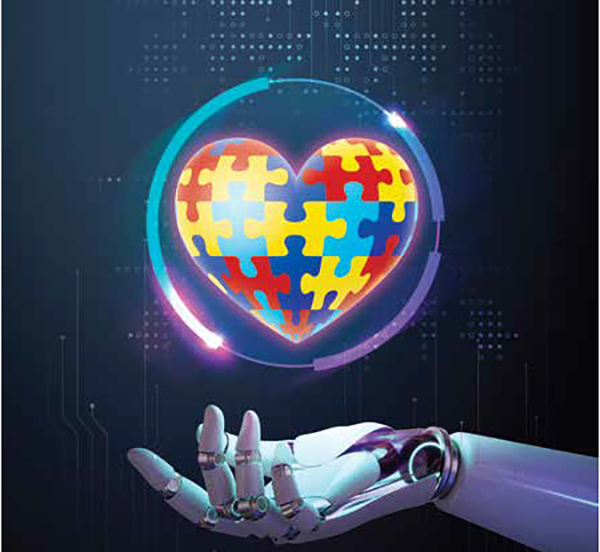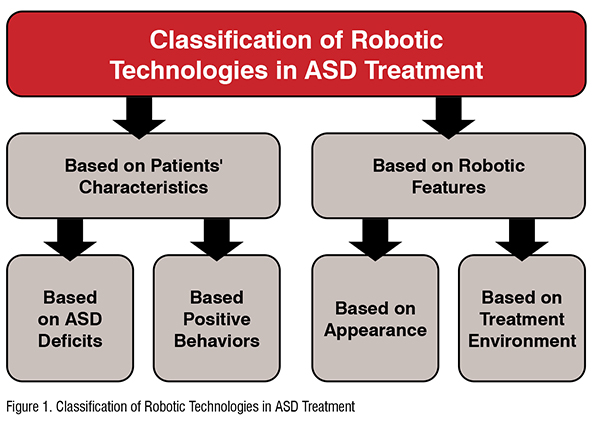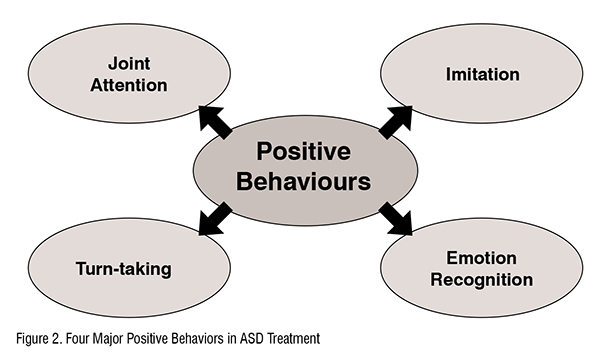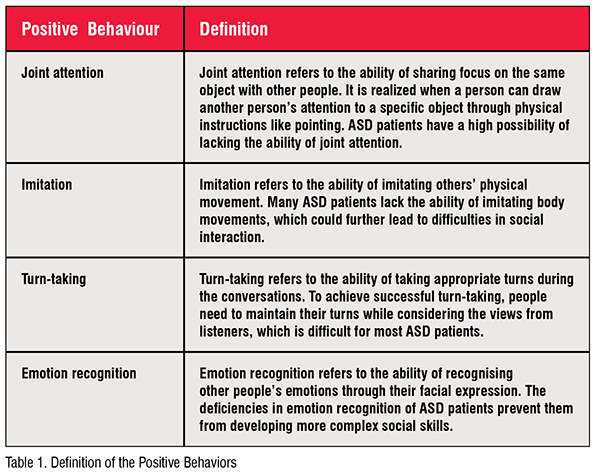Autism is a complex, lifelong developmental condition that typically appears during early childhood and can impact a person’s social skills, communication and relationships. Various technologies, such as robots, VR/AR and eye tracking are being investigated for the diagnosis and treatment of autism. This article presents a summary of recent research on the use of robots for autism.

Autism Spectrum Disorder (ASD), hereafter referred to as Autism (which includes Asperger’s Disorder and Pervasive Developmental Disorder – Not Otherwise Specified[PDD-NOS]), is a complex, lifelong developmental condition that typically appears during early childhood and can impact a person’s social skills, communication, relationships, and self-regulation. The autism experience is different for different ASD affected people. It is defined by a certain set of behaviours and is often referred to as a “spectrum condition” that affects people differently and to varying degrees. While there is currently no known single cause of Autism, early diagnosis helps a person receive resources that can support the choices and opportunities needed to live fully.1
The prevalence of ASD has been increasing steadily over the past two decades. Luckily, with the advance of information technology, human society can tackle ASD much more maturely than in the past. Today, information technologies such as robotic technologies offer some promises in the treatment of ASD patients as discussed in this article. This article presents a classification criteria for robotic technologies for ASD management based on the criteria, the real-world applications of these robotic technologies are discussed from the aspects of joint-attention, imitation, turn-taking and emotion recognition. Finally, the article presents some evolving low-cost technologies for the management of ASD at homes and schools.
The development of robotic technologies brings new possibilities to both ASD diagnosis and treatment. Previous literature shows that the use of robotic technologies in ASD treatment is quite beneficial since ASD patients have challenges in interacting with real people while showing interest in interacting with robots.2 Robotic technologies have been applied to ASD treatment in many studies from several different aspects including training joint attention, improving imitation ability, teaching turn-taking activities and strengthening emotion recognition skills. These ASD treatments based on robotic technologies need knowledge from diverse disciplines, including psychology, computer science and robotics, which makes it hard for researchers to see the relationships between different robotic technologies for ASD treatment. To provide an overview of the robotic technologies for ASD treatment, the following sections discusses several classification criteria for robotic technologies in ASD treatments.
There are many classifications of robotic technologies for ASD treatment. As shown in Figure 1, some studies classified these technologies based on the characteristics of ASD patients while other studies used robotic features as the criteria to classify these robotic technologies.
Considering the characteristics of ASD patients, many studies classified robotic technologies for ASD treatment based on the major deficiencies of ASD patients. The criteria provided in the DSM-5 for diagnosing ASD includes three deficiencies in social communication and interaction, which are “difficulties in social emotional reciprocity”, “difficulties in non-verbal communication used for social interaction” and “deficiencies in developing and maintaining relationships with other people”. Since many robotic technologies for ASD treatment are designed to treat one of these three specific deficiencies, they can be classified based on the deficits that they aim to treat.
Another widely used classification is based on the positive behaviours that the robotic technologies aim to achieve. Since it is relatively hard to solve the three deficiencies of ASD patients directly, many therapies solve the deficiencies by decomposing the treatment into teaching ASD patients positive behaviours. These behaviours include joint-attention, imitation, turn-taking, emotion recognition etc. By learning these positive behaviours and applying these social skills in their daily life, ASD patients will face fewer problems in social communication and interaction. Therefore, as many robotic technologies are designed to teach the ASD patients specific positive behaviours they can be classified by the positive behaviours that they want to achieve.
While the two classifications mentioned above are mainly based on the deficiencies and behaviours of ASD patients, there are also classifications based on the features of robotic technology itself. For example, based on appearance, robots used in ASD treatment can be classified as human-like, animal-like and toy robots. The robotic technologies can also be classified as home-based, play-based and educationbased robotic technologies considering the treatment environment.

In this section, several real-world applications are analysed to give an overview of the current robotic technologies used in ASD treatment. As shown in Figure 2, using the classification that is based on positive behaviour, this section will mainly analyse the application of robotic technology in joint-attention, imitation, turn-taking and emotion recognition, which are the most popular research focuses nowadays. The definitions of these positive behaviours is shown in Table 1.
Joint attention
In joint attention therapies, the robots give instructions to ASD patients and ask them to focus on a specific object or location. After giving the instructions, the robot measures the attention of the ASD patients and give the corresponding feedback based on the measurement data to reinforce the ASD patients’ ability of joint attention. Since ASD patients have difficulties in direct communication and interaction with other people, using robots in joint attention training can greatly improve the training efficiency by eliminating the communication barriers. In addition, the robots have a stronger ability to measure patients’ attention than humans with the aid of eye-tracking technologies.
Imitation
Imitation intervention mainly uses robots to replace human therapists in imitation training. During the training, robots present specific gestures for the patients to imitate and provide corresponding feedback based on the recognition of patients’ gestures. In some studies, the instructions are not limited to gestures and higher-level human behaviours such as facial expressions can also be used for imitation training. The application of robots in imitation training improves the efficiency of imitation intervention, since ASD patients will have less difficulties in interacting with robots compared with human therapists. Moreover, the mobility and programmable features of the robots also contribute to the training efficiency.
Turn-taking
The application of robotic technologies in training turn-taking ability also uses robots to replace therapists in treatment. In the treatment, ASD patients need to complete the turntaking tasks with their robot partners and the robots will provide feedback based on their performance. Although human intervention can also achieve similar result of improving turn-taking ability, robot-enhanced treatment still has advantages in attracting ASD children due to the nature of ASD patients, which makes the robotenhanced treatment more efficient than traditional human intervention therapy.
Emotion recognition
Emotion recognition training commonly uses robots to imitate human beings’ facial expressions. During the treatment, the robots will perform several specific facial expressions and the participants need to identify the emotion behind the corresponding facial expressions. Since ASD patients have less difficulties in interacting with robots and the facial expressions imitated by robots are less complex compared with facial expressions of human faces, it is much easier for ASD patients to recognise the emotions behind facial expressions. The practice of recognising robots’ facial expressions can act as an intermediate step of learning recognising humans’ facial expressions for ASD patients. In some studies, emotion recognition training is combined with imitation training to achieve a better outcome.
Building portable technologies for low-cost management of ASD
Worldwide, roughly 6 per cent of the population suffer from ASD. More cases are seen in developing countries. India has the largest number of autistic children (approximately 1 million), followed by China (approximately 0.5 million). Imbalanced medical resources and the COVID-19 pandemic situation necessitate remote ASD management.


Different kinds of equipment are required to quantitatively assess the performance of ASD patients. However, traditional devices for research labs and hospitals like eye trackers are too expensive for individuals to afford at home or in schools. Recent advances in webcam based eye-tracking, virtual reality (VR) and augmented reality (AR) technologies make it possible to screen, diagnose and track behaviours of ASD patients during treatment with portable, low-cost devices.
Eye-tracking is a significant technology to assess the joint attention and thus diagnose ASD patients as mentioned. Researchers have developed webcam eye-tracking platforms such as RealEye. The technology captures eye movement of users based on video stream, analyses the gaze patterns, saccades etc., and predicts possibility of having ASD or seriousness of condition through a trained deep learning network. High accuracy in eye movement based ASD diagnosis and little requirement on devices show great promise in the development of this technology.
VR/AR further improves the treatment effect and cuts down the cost. Lacking the ability of joint attention, it is hard to conduct treatment remotely through a screen. VR/AR create a 360-degree virtual space to animate reallife scenarios, which keep the attention of ASD patients on the interactive video stimuli without being affected by the movement of ASD patients. It also eliminates the need for building humanlike robots and thus increases portability. Besides, many VR helmets are equipped with eye-tracking module, so it is possible to track reactions of patients during treatment.
Conclusion
In this paper, the applications of robotic technologies in ASD treatment are introduced and several classification criteria for these robotic technologies are discussed. Based on the classification, several realistic applications of robotic technologies for ASD treatment are analysed. The common classifications used are mainly based on the characteristics of ASD patients or the features of the robotics used.
From the analysis of the realistic robotic technologies for ASD treatment, it can be concluded that the applications of robotic technologies in ASD management mainly make use of the characteristics of ASD patients. Since ASD patients face difficulties in interacting and communicating with other people and ASD patients show a higher interest in interacting with robots, using robots to replace human therapists in ASD treatment can greatly improve the efficiency of ASD management.
References:
1 Autism Society, see https://autismsociety.org/the-autismexperience/,accessed Jan 2022
2 Alabdulkareem, Amal, Noura Alhakbani, and Abeer Al-Nafjan. "A Systematic Review of Research on Robot-Assisted Therapy for Children with Autism." Sensors 22.3 (2022): 944.